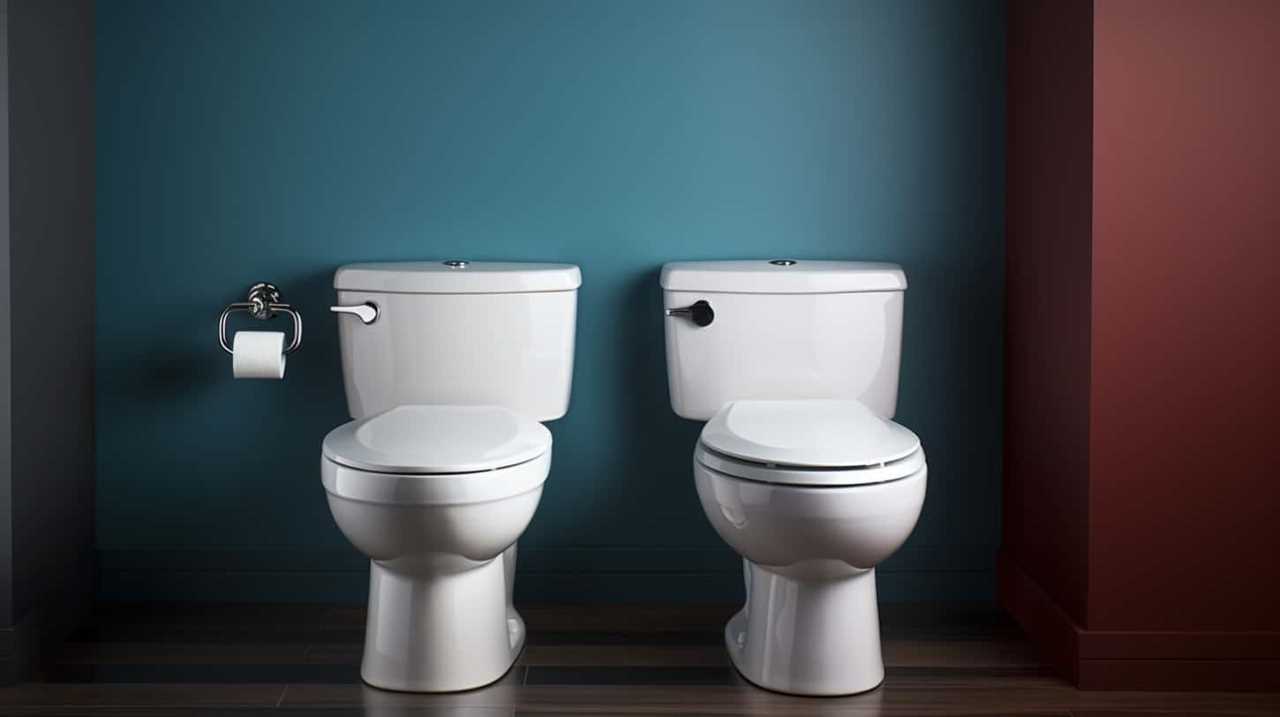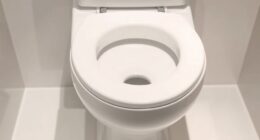As a homeowner, I know firsthand the frustration of dealing with rusted tank bolts on a toilet. But fear not, because I’ve got you covered with this comprehensive guide on efficient rusted tank bolt removal.
In just a few simple steps, I’ll show you how to tackle this problem head-on and get your toilet back in tip-top shape. So let’s roll up our sleeves and dive into the nitty-gritty of removing those stubborn bolts.
Trust me, you’ll be a pro in no time!
Key Takeaways
- Preparation and inspection are crucial before starting any work on removing rusted tank bolts.
- Non-rusted bolts can be easily removed with a screwdriver and wrench.
- Rusted bolts may require additional tools such as vice-grip pliers, hacksaw, or penetrating oil for easier removal.
- When installing new bolts, choose bronze bolts for better durability and resistance to rust.
Proper Preparation and Inspection
Before starting any work, I always make sure to drain the water from the toilet bowl and turn off the water supply line to ensure a clean and dry working area.
Common causes of rust on toilet tank bolts include moisture buildup, exposure to water, and the use of low-quality materials.
To prevent rust from forming on toilet tank bolts, it is important to keep the area dry and free from moisture. Regularly inspect the bolts for any signs of rust and replace them if necessary.
Additionally, using high-quality bolts made of materials such as bronze or brass can help prevent rust formation. Applying a rust-resistant coating or sealant can also provide added protection.
Proper maintenance and care are essential in preventing rust and ensuring the longevity of toilet tank bolts.
Removing Non-Rusted Bolts
I can use a screwdriver and wrench to easily remove bolts that are not rusted.
- Position the screwdriver on the bolt head to hold it in place.
- Use the wrench to loosen the bolt by turning it counterclockwise.
- Ensure not to tighten the bolt with the screwdriver, as it may cause future problems.
- Recognize the simplicity of removing non-rusted bolts compared to rusted ones.
- Remember the importance of regular maintenance to prevent rust formation.
Preventing rust formation is crucial in maintaining the integrity of bolts. However, if bolts do become rusted, alternative removal methods may be necessary. By following proper instructions and using the appropriate tools, rusted bolts can be successfully removed without causing damage to the toilet.
It is essential to assess the level of rust and attempt to loosen it using vice-grip pliers and a wrench. Additionally, penetrating oils can be applied to soften and break down the rust for easier bolt removal. In some cases, using a hacksaw or a reciprocating saw may be required to cut through severely rusted bolts.
Dealing With Rusted Bolts
When dealing with rusted bolts, it is important to assess the level of rust before attempting to loosen them. This will determine the best technique to use and prevent any further damage.
One technique for preventing rust on toilet tank bolts is to apply a thin layer of petroleum jelly or silicone grease to the bolt threads. This creates a barrier that prevents moisture from reaching the metal and causing rust.
Another technique is to use stainless steel or brass bolts, as they are less prone to rusting.
Common mistakes to avoid when dealing with rusted bolts include using excessive force, which can strip or break the bolts, and not using the proper tools, such as vice-grip pliers or a hacksaw.
Installing New Bolts
To install new bolts, simply screw the nut onto the bolt and avoid over-tightening to prevent damage to the toilet. When choosing the right bolt material, it is important to consider durability and resistance to rust. Bronze bolts are a good option for their longevity and rust resistance.
Proper bolt tightening techniques are crucial for optimal performance and to avoid potential issues. Here are five key points to keep in mind:
- Start tightening the bolts by hand or with a small wrench.
- Tighten both bolts simultaneously to ensure even pressure.
- Be careful when the bolts start to feel firm, avoiding excessive tightening.
- Over-tightening can lead to cracks in the toilet and potential leaking.
- Follow a half-turn more tightening approach for optimal results.
Tips and Recommendations for Efficient Bolt Removal
Using penetrating oils can help soften and break down rust on the bolts, making them easier to remove.
When dealing with stubborn bolts, consider using a reciprocating saw or bolt cutters. These tools can provide the necessary force to cut through the rust and free the bolts.
Before using the reciprocating saw or bolt cutters, ensure that you have taken all safety precautions, such as wearing protective gloves and goggles.
Carefully position the saw or cutters on the rusted area of the bolt and apply steady pressure while cutting. It may take some time and effort, but with persistence, the stubborn bolts can be removed.
Remember to always work in a controlled manner to avoid damaging the surrounding areas.
Frequently Asked Questions
How Long Should the Penetrating Oil Sit on the Rusted Bolts Before Attempting to Remove Them?
I let the penetrating oil sit on the rusted bolts for at least ten minutes before attempting to remove them. This helps prevent bolt corrosion and allows for easier removal without damaging surrounding parts.
Are There Any Alternative Methods to Remove Rusted Bolts if Vice-Grip Pliers and a Wrench Are Not Effective?
Using an impact wrench is an effective alternative method for removing rusted bolts if vice-grip pliers and a wrench are not effective. The high torque and vibration help break the rust bond, making bolt removal easier.
Can I Use Regular Steel Bolts Instead of Bronze Bolts for Installing New Bolts?
Yes, you can use regular steel bolts instead of bronze bolts for installing new bolts. However, bronze bolts offer better durability and resistance to rust, making them a more reliable choice in the long run.
What Should I Do if I Accidentally Crack the Vitreous China Material of the Toilet While Tightening the Bolts?
If I accidentally crack the vitreous china material of the toilet while tightening bolts, I would stop immediately and assess the extent of the damage. Repairing cracked vitreous china toilets may require professional help or replacing the toilet altogether.
Are There Any Specific Precautions I Should Take When Removing Rusted Bolts From Older or Vintage Toilets?
When removing rusted bolts from older or vintage toilets, it’s crucial to take safety measures. Use proper tools and techniques to avoid damaging the toilet. Follow instructions carefully to ensure efficient bolt removal.
Conclusion
In conclusion, the process of efficiently removing rusted tank bolts from a toilet requires careful preparation and inspection. Just as rust corrodes these bolts, neglecting regular maintenance can corrode the overall functionality of your toilet.
By taking the time to drain the water, turn off the water supply, and inspect the bolts, you can tackle the issue with precision and efficiency. Remember, the tools you choose, such as vice-grip pliers or a hacksaw, symbolize your determination to overcome the rust’s grip.
Applying penetrating oil softens the rust’s hold, while a mini hacksaw or bolt cutters demonstrate your commitment to resolving the problem. Finally, when installing new bolts, choose durable bronze bolts and avoid over-tightening.
By following these steps and incorporating regular maintenance into your routine, you can ensure a rust-free and smoothly functioning toilet.










